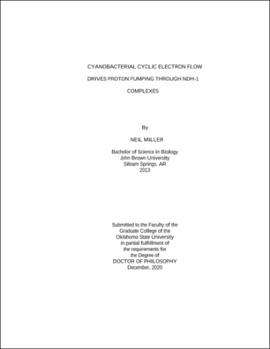| dc.contributor.advisor | Burnap, Robert L. | |
| dc.contributor.author | Miller, Neil | |
| dc.date.accessioned | 2021-08-03T18:48:48Z | |
| dc.date.available | 2021-08-03T18:48:48Z | |
| dc.date.issued | 2020-12 | |
| dc.identifier.uri | https://hdl.handle.net/11244/330182 | |
| dc.description.abstract | In cyanobacteria and other photosynthetic organisms, cyclic electron flow (CEF) around Photosystem I (PSI) is a crucial mechanism for balancing the photosynthetically produced energy carriers NADPH and ATP that are utilized to accumulate biomass. This is accomplished via the oxidation of NADPH by membrane oxidoreductases which pass the electrons into the membrane-soluble PQ pool and back to PSI where ferredoxin (Fd) and NADP+ are reduced, completing the cycle. This cyclic flow drives the pumping of protons across the thylakoid membrane, driving the operation of ATP-synthase and thereby increasing the ATP/NADPH ratio with no net consumption of NADPH. A major participant in CEF are the NDH-1 complexes, homologs to respiratory complex I. Cyanobacteria possess four versions of this complex that participate in CEF as well as CO2 uptake. While the activity of these complexes in pumping protons is known in other organisms, and the closely related chloroplast NDH-1 had recently been shown to do so, information on these complexes in cyanobacteria is lacking regarding proton pumping activity. As well, in cyanobacteria, these complexes were demonstrated to utilize Fd as a reductant source instead of NAD(P)H as is typical for its homologs. Cyanobacteria also possess a system to regulate the redox state of the Fd/NADPH pools by exchanging electrons between them, termed the Fd:NADP-oxidoreductase (FNR). Some cyanobacteria, like Synechocystis sp. PCC6803, possess two isoforms of FNR, FNRS and FNRL, that share a gene and are differentially expressed by different translation initiations, and are thought to primarily operate in NADPH oxidation and NADP+ reduction respectively, though there are still large gaps in understanding their physiological functions. In this work, it is hypothesized that CEF is a major driver of proton pumping and that NDH-1 complexes are the driving force of that proton pumping. It is also hypothesized that the activity of FNRS feeds NDH-1 with reduced Fd, allowing enhancement of proton pumping during acclimation to fluctuating light conditions, a major stressor of photosynthetic organisms. | |
| dc.format | application/pdf | |
| dc.language | en_US | |
| dc.rights | Copyright is held by the author who has granted the Oklahoma State University Library the non-exclusive right to share this material in its institutional repository. Contact Digital Library Services at lib-dls@okstate.edu or 405-744-9161 for the permission policy on the use, reproduction or distribution of this material. | |
| dc.title | Cyanobacterial cyclic electron flow drives proton pumping through NDH-1 complexes | |
| dc.contributor.committeeMember | Lutter, Erika I. | |
| dc.contributor.committeeMember | Prade, Rolf A. | |
| dc.contributor.committeeMember | Hoff, Wouter D. | |
| dc.contributor.committeeMember | Henley, William J. | |
| osu.filename | Miller_okstate_0664D_16957.pdf | |
| osu.accesstype | Open Access | |
| dc.type.genre | Dissertation | |
| dc.type.material | Text | |
| dc.subject.keywords | cyclic electron flow | |
| dc.subject.keywords | fluorescence | |
| dc.subject.keywords | fnr | |
| dc.subject.keywords | ndh-1 | |
| dc.subject.keywords | photosynthesis | |
| dc.subject.keywords | proton pumping | |
| thesis.degree.discipline | Microbiology and Molecular Genetics | |
| thesis.degree.grantor | Oklahoma State University | |
